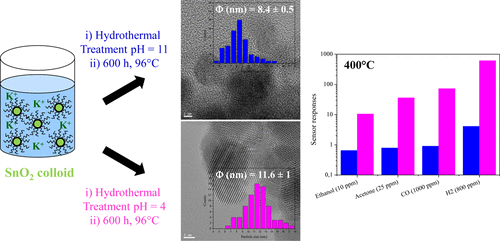当前位置:
X-MOL 学术
›
ACS Appl. Mater. Interfaces
›
论文详情
Our official English website, www.x-mol.net, welcomes your
feedback! (Note: you will need to create a separate account there.)
Finely Tuned SnO2 Nanoparticles for Efficient Detection of Reducing and Oxidizing Gases: The Influence of Alkali Metal Cation on Gas-Sensing Properties
ACS Applied Materials & Interfaces ( IF 8.3 ) Pub Date : 2018-03-05 00:00:00 , DOI: 10.1021/acsami.7b18140 Szu-Hsuan Lee 1, 2 , Vardan Galstyan 3, 4 , Andrea Ponzoni 3, 4 , Isabel Gonzalo-Juan 2 , Ralf Riedel 2 , Marie-Anne Dourges 1 , Yohann Nicolas 1 , Thierry Toupance 1
ACS Applied Materials & Interfaces ( IF 8.3 ) Pub Date : 2018-03-05 00:00:00 , DOI: 10.1021/acsami.7b18140 Szu-Hsuan Lee 1, 2 , Vardan Galstyan 3, 4 , Andrea Ponzoni 3, 4 , Isabel Gonzalo-Juan 2 , Ralf Riedel 2 , Marie-Anne Dourges 1 , Yohann Nicolas 1 , Thierry Toupance 1
Affiliation

|
Tin dioxide (SnO2) nanoparticles were straightforwardly synthesized using an easily scaled-up liquid route that involves the hydrothermal treatment, either under acidic or basic conditions, of a commercial tin dioxide particle suspension including potassium counterions. After further thermal post-treatment, the nanomaterials have been thoroughly characterized by Fourier transform infrared and Raman spectroscopy, powder X-ray diffraction, transmission electron microscopy, X-ray photoelectron spectroscopy, and nitrogen sorption porosimetry. Varying pH conditions and temperature of the thermal treatment provided cassiterite SnO2 nanoparticles with crystallite sizes ranging from 7.3 to 9.7 nm and Brunauer–Emmett–Teller surface areas ranging from 61 to 106 m2·g–1, acidic conditions favoring potassium cation removal. Upon exposure to a reducing gas (H2, CO, and volatile organic compounds such as ethanol and acetone) or oxidizing gas (NO2), layers of these SnO2 nanoparticles led to highly sensitive, reversible, and reproducible responses. The sensing results were discussed in regard to the crystallite size, specific area, valence band energy, Debye length, and chemical composition. Results highlight the impact of the counterion residuals, which affect the gas-sensing performance to an extent much higher than that of size and surface area effects. Tin dioxide nanoparticles prepared under acidic conditions and calcined in air showed the best sensing performances because of lower amount of potassium cations and higher crystallinity, despite the lower surface area.
中文翻译:

精细调谐的SnO 2纳米颗粒,可有效检测还原性和氧化性气体:碱金属阳离子对气体传感性能的影响
使用易于放大的液体途径直接合成二氧化锡(SnO 2)纳米颗粒,该方法涉及在酸性或碱性条件下对包含钾抗衡离子的商业二氧化锡颗粒悬浮液进行水热处理。经过进一步的热后处理,纳米材料已经通过傅立叶变换红外和拉曼光谱,粉末X射线衍射,透射电子显微镜,X射线光电子能谱和氮吸附孔隙率法进行了全面表征。pH值条件和热处理温度的变化提供了锡石SnO 2纳米粒子,其晶粒尺寸范围为7.3至9.7 nm,Brunauer-Emmett-Teller表面积为61至106 m 2 ·g–1,有利于去除钾阳离子的酸性条件。暴露于还原性气体(H 2,CO和挥发性有机化合物,如乙醇和丙酮)或氧化性气体(NO 2)时,这些SnO 2层纳米颗粒导致高度敏感,可逆和可再现的响应。讨论了有关晶粒尺寸,比表面积,价带能,德拜长度和化学组成的传感结果。结果突出了抗衡离子残留物的影响,该影响对气体传感性能的影响远大于尺寸和表面积影响。尽管表面积较小,但在酸性条件下制备并在空气中煅烧的二氧化锡纳米颗粒显示出最佳的感测性能,这是因为钾离子的含量较低且结晶度较高。
更新日期:2018-03-05
中文翻译:

精细调谐的SnO 2纳米颗粒,可有效检测还原性和氧化性气体:碱金属阳离子对气体传感性能的影响
使用易于放大的液体途径直接合成二氧化锡(SnO 2)纳米颗粒,该方法涉及在酸性或碱性条件下对包含钾抗衡离子的商业二氧化锡颗粒悬浮液进行水热处理。经过进一步的热后处理,纳米材料已经通过傅立叶变换红外和拉曼光谱,粉末X射线衍射,透射电子显微镜,X射线光电子能谱和氮吸附孔隙率法进行了全面表征。pH值条件和热处理温度的变化提供了锡石SnO 2纳米粒子,其晶粒尺寸范围为7.3至9.7 nm,Brunauer-Emmett-Teller表面积为61至106 m 2 ·g–1,有利于去除钾阳离子的酸性条件。暴露于还原性气体(H 2,CO和挥发性有机化合物,如乙醇和丙酮)或氧化性气体(NO 2)时,这些SnO 2层纳米颗粒导致高度敏感,可逆和可再现的响应。讨论了有关晶粒尺寸,比表面积,价带能,德拜长度和化学组成的传感结果。结果突出了抗衡离子残留物的影响,该影响对气体传感性能的影响远大于尺寸和表面积影响。尽管表面积较小,但在酸性条件下制备并在空气中煅烧的二氧化锡纳米颗粒显示出最佳的感测性能,这是因为钾离子的含量较低且结晶度较高。









































 京公网安备 11010802027423号
京公网安备 11010802027423号